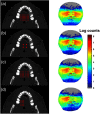Monte Carlo modeling of light propagation in the human head for applications in sinus imaging
- PMID: 25781310
- PMCID: PMC4362326
- DOI: 10.1117/1.JBO.20.3.035004
Monte Carlo modeling of light propagation in the human head for applications in sinus imaging
Abstract
Sinus blockages are a common reason for physician visits, affecting one out of seven people in the United States, and often require medical treatment. Diagnosis in the primary care setting is challenging because symptom criteria (via detailed clinical history) plus objective imaging [computed tomography (CT) or endoscopy] are recommended. Unfortunately, neither option is routinely available in primary care. We previously demonstrated that low-cost near-infrared (NIR) transillumination correlates with the bulk findings of sinus opacity measured by CT. We have upgraded the technology, but questions of source optimization, anatomical influence, and detection limits remain. In order to begin addressing these questions, we have modeled NIR light propagation inside a three-dimensional adult human head constructed via CT images using a mesh-based Monte Carlo algorithm (MMCLAB). In this application, the sinus itself, which when healthy is a void region (e.g., nonscattering), is the region of interest. We characterize the changes in detected intensity due to clear (i.e., healthy) versus blocked sinuses and the effect of illumination patterns. We ran simulations for two clinical cases and compared simulations with measurements. The simulations presented herein serve as a proof of concept that this approach could be used to understand contrast mechanisms and limitations of NIR sinus imaging.
Figures









Similar articles
-
Near-Infrared Optical Imaging for Diagnosis of Maxillary Sinusitis.Otolaryngol Head Neck Surg. 2016 Sep;155(3):538-41. doi: 10.1177/0194599816655309. Epub 2016 Jun 21. Otolaryngol Head Neck Surg. 2016. PMID: 27329417
-
Special radiologic imaging of paranasal sinuses. A prerequisite for functional endoscopic sinus surgery.Eur J Radiol. 1988 Aug;8(3):153-6. Eur J Radiol. 1988. PMID: 3169025
-
[The valuation of paranasal sinus coronal CT scanning in endoscopy sinus surgery].Lin Chuang Er Bi Yan Hou Ke Za Zhi. 1998 Aug;12(8):346-8. Lin Chuang Er Bi Yan Hou Ke Za Zhi. 1998. PMID: 11263154 Chinese.
-
Chronic sinusitis: the role of imaging.Acta Otorhinolaryngol Belg. 1997;51(4):247-58. Acta Otorhinolaryngol Belg. 1997. PMID: 9444373 Review.
-
The ostiomeatal unit and endoscopic surgery: anatomy, variations, and imaging findings in inflammatory diseases.AJR Am J Roentgenol. 1992 Oct;159(4):849-57. doi: 10.2214/ajr.159.4.1529853. AJR Am J Roentgenol. 1992. PMID: 1529853 Review.
References
-
- Stankiewicz J. A., Chow J. M., “A diagnostic dilemma for chronic rhinosinusitis: definition accuracy and validity,” Am. J. Rhinol. 16, 199–202 (2002).AJRHE5 - PubMed

